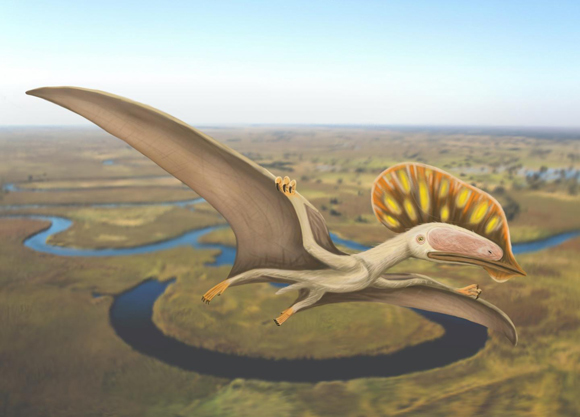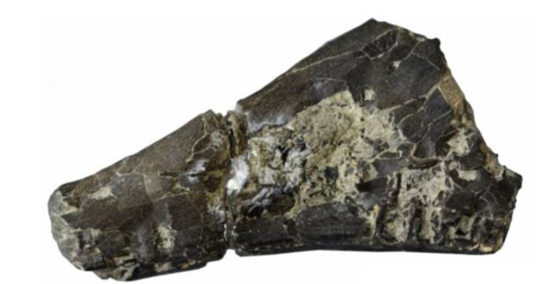Wightia declivirostris – A Terrific Tapejarid Pterosaur
Jawbone Leads to an Isle of Wight Tapejarid Pterosaur
A single, fragmentary jawbone from the upper jaw of a pterosaur found on the Isle of Wight has demonstrated just how diverse and widespread the Tapejaridae family of pterosaurs were. The fossil bone, a partial premaxilla from the Lower Cretaceous (Barremian) Wessex Formation of Yaverland (Isle of Wight), represents a new species, the first record of a tapejarid pterosaur from the Wessex Formation and one of the oldest examples of this pterosaur family to have been found outside of China. The flying reptile has been named Wightia declivirostris.
Wightia declivirostris
A Life Reconstruction of Wightia declivirostris (Wessex Formation)

Picture credit: Megan Jacobs (University of Portsmouth)
Terrific Toothless Tapejarids
The terrific toothless tapejarids with their reputation for taking head crest development to the extreme, are known from relatively abundant fossil material associated with the Santana and Crato Formations of Brazil. In addition, several members of the Tapejaridae family are associated with the Jiufotang Formation of China. However, fragmentary fossils are known from elsewhere in the world such as Spain (Europejara olcadesorum) and a toothless, rather deep lower jaw tip along with other partial bones from the Kem Kem beds of Morocco suggests that these types of flying reptile may have persisted into the early Late Cretaceous.
Two of the authors associated with this scientific paper, Professor David Martill and Roy Smith (both from the University of Portsmouth), recently published a report on the discovery of a north African tapejarid which was named Afrotapejara zouhrii, one of a spate of recent Moroccan pterosaur discoveries. To read Everything Dinosaur’s article about this: That Fourth Moroccan Pterosaur. It seems that these fancy-crested, edentulous flying reptiles were much more geographically and temporally diverse than previously thought.
A Typical Illustration of a Tapejarid Pterosaur (Tupandactylus imperator)

Picture credit: Everything Dinosaur
The Isle of Wight Pterosaur is More Closely Related to Chinese Tapejarids
Amateur fossil hunter John Winch discovered a pterosaur snout near the cliff at Yaverland Point in Sandown Bay, in a fossil plant debris layer. The unusual shape and thin bone walls suggested that it was from a pterosaur. The fragment of jaw, although eroded, demonstrates the characteristic downturned tip, with numerous tiny holes (foramina), on the occulsal surface which indicate the presence of minute sensory organs for detecting food.
The Holotype Material Wightia declivirostris
Picture credit: University of Portsmouth
The jaw fragment was passed to palaeontology student at Portsmouth University, Megan Jacobs, who confirmed it was a rare find and definitely pterosaurian. Analysis of the specimen suggests that Wightia is more closely related to the older and more primitive tapejarid Sinopterus from Liaoning (Jiufotang Formation), than it is to Brazilian tapejarids. The genus name of this newly described flying reptile honours the Isle of Wight, whilst the species (trivial) name means “slanting beak”, a reference to the typically tapejarid morphology of the partial premaxilla.
Both the Wealden Formation and the geologically younger Vectis Formation on the Isle of Wight have yielded pterosaur specimens, although they tend to consist of highly fragmentary remains. The discovery of Wightia declivirostris demonstrates how significant the Lower Cretaceous Isle of Wight sediments are to palaeontologists as they try to plot the radiation of different types of flying reptile during the Early Cretaceous.
The scientific paper: “First tapejarid pterosaur from the Wessex Formation (Wealden Group: Lower Cretaceous, Barremian) of the United Kingdom” by David M. Martill, Mick Green, Roy E. Smith, Megan L. Jacobs and John Winch published in the journal Cretaceous Research.
The Everything Dinosaur website: Everything Dinosaur.


